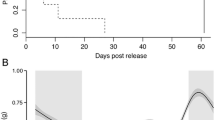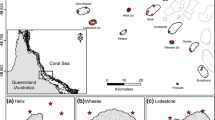Abstract
Free-ranging female grey reef sharks, Carcharhinus amblyrhynchos, were observed forming daily aggregations offshore Sand Island, Johnston Atoll between March and late May from 1992 to 1995. Daily water temperatures were recorded at the aggregation area from 1993 to 1995. The annual aggregation cycle did not coincide with maximum or minimum annual water temperatures. During the 1994 aggregation, temperatures were recorded at least every hour at 7 sites in the Atoll. The sharks aggregated most frequently and in highest numbers at the largest and shallowest site, which also contained the fewest underwater structures. The water temperature at this site was 1–2 °C warmer than at neighboring sites and at a reef channel between the lagoon and the open ocean. The pattern of movement of sharks to and from the aggregation area was correlated with daily fluctuations of water temperature (r=0.38; p < 0.001), tide (r=0.30; p < 0.001) and light level (r=0.21; p < 0.001) after adjustment for autocorrelated errors. The daily maximum number of aggregating sharks coincided with the daily maximum water temperature. However, the number of aggregating sharks did not necessarily increase during days of higher water temperature. During the 1994 aggregation period, four sharks were fed ultrasonic telemetry tags, and telemetry stations were deployed at three sites within the aggregation area. Individual sharks were tracked returning to the aggregation area for durations of one to five days. The end of detection of tagged sharks is thought to be due to the regurgitation of the indigestible tags, rather than the sharks permanent departure from the aggregating area. Sharks aggregated only during the day; none of the tagged sharks were recorded and no sharks were ever seen at the aggregation area during night time.
Similar content being viewed by others
References cited
Carey, F.G. & J.V. Scharold. 1990. Movements of blue sharks (Prionace glauca) in depth and course. Mar. Biol. 106: 329–342.
Carrier, J.C., J.H.L. Pratt & L.K. Martin. 1994. Group reproductive behaviors in free-living nurse sharks, Ginglymostoma cirratum. Copeia 1994: 646–656.
Castro, J.I. 1993. The biology of the finetooth shark, Carcharhinus isodon. Env. Biol. Fish. 36: 219–232.
Compagno, L.J.V. 1984. Sharks of the world. An annotated and illustrated catalogue of shark species known to date. FAO species catalogue, Vol. 4, Part 2, Carcharhiniformes, U.N. Dev. Prog., FAO, Rome. 655 pp.
Harris, J.E. 1952. A note on the breeding season, sex ratio and embryonic development of the dogfish Scyliorhinus canicula (L.). J. Mar. Biol. Assoc U.K. 31: 269–275.
Jensen, A.C. 1965. Life history of the spiny dogfish. U.S. Fish. Bull. 65: 527–554.
Johnson, R.H. 1978. Sharks of Polynesia. Les Editions du Pacifique, Singapore. 170 pp.
Kenney, N.T. 1968. Sharks: wolves of the sea. Nat. Geogr. Mag. 133: 222–257.
Klimley, A.P. 1980. Observations of courtship and copulation in the nurse shark, Ginglymostoma cirratum. Copeia 1980: 878–882.
Klimley, A.P. 1985. Schooling in Sphyrna lewini, a species with low risk of predation: a non-egalitarian state. Z. Tierpsychol. 70: 297–319.
Klimley, A.P. 1987. The determinants of sexual segregation in the scalloped hammerhead shark, Sphyrna lewini. Env. Biol. Fish. 18: 27–40.
Klimley, A.P. 1995. Hammerhead city. Natural History 104: 32–39.
Klimley, A.P., S.B. Butler, D.R. Nelson, & A.T. Stull. 1988. Diel movements of scalloped hammerhead sharks, Sphyrna lewini Griffith and Smith, to and from a seamount in the Gulf of California. J. Fish Biol. 33: 751–761
Klimley, A.P. & D.R. Nelson. 1981. Schooling of the scalloped hammerhead shark, Sphyrna lewini, in the Gulf of California. U.S. Fish. Bull. 79: 356–360.
Klimley, A.P. & D.R. Nelson. 1984. Diel movement patterns of the scalloped hammerhead shark (Sphyrna lewini) in relation to El Bajo Espiritu Santo: a refuging central-position social system. Behav. Ecol. Sociobiol. 15: 45–54.
McKibben, J.N. & D.R. Nelson. 1986. Patterns of movements and grouping of grey reef sharks, Carcharhinus amblyrhynchos, at Enewetak, Marshal Islands. Bull. Mar. Sci. 38: 89–110.
Morrissey, J.F. & S.H. Gruber. 1993. Habitat selection by juvenile lemon sharks, Negaprion brevirostris. Env. Biol. Fish. 38: 311–319.
Olsen, A.M. 1954. The biology, migration, and growth rate of the school shark, Galeorhinus australis (Macleay) (Carcharhanidae) in south-eastern Australian waters. Aust. J. Mar. Freshwater Res. 5: 353–410.
Precht, H., J. Cristophersen, H. Hensel & W. Larcher. 1973. Temperature and life. Springer Verlag, Berlin. 779 pp.
Randall, J.E. 1977. Contribution to the biology of the whitetip reef shark (Triaenodon obesus). Pac. Sci. 31: 143–164.
Springer, S. 1960. Natural history of the sandbar shark, Eulamia milberti. U.S. Fish. Bull. 61: 1–38.
Springer, S. 1967. Social organization of shark populations. pp.149–174. In: P. W. Gilbert, R.F. Mathewson & D.P. Rall (ed.) Sharks, Skates and Rays, Johns Hopkins Press, Baltimore.
Stevens, J.D, 1976. The occurrence and significance of tooth cuts on the blue shark, (Prionace glauca L.) from British waters. J. Mar. Biol. Ass. U.K. 54: 373–378.
Stevens, J.D. & K.J. Mcloughlin. 1991. Distribution, size and sex composition, reproductive biology and diet of sharks from Northern Australia. Aust. J. Mar. Freshwater Res. 42: 151–199.
Taylor, L. 1993. Sharks of Hawai'i: their biology and cultural significance. University of Hawaii Press, Honolulu. 126 pp.
Wass, R.C. 1971. A comparative study of the life history, distribution and ecology of the sandbar shark and the grey reef shark in Hawaii. Ph.D. Dissertation, University of Hawaii, Honolulu. 219 pp.
Wourms, J.P. 1977. Reproduction and development in chondrichthyan fishes. Amer. Zool. 17: 379–410.
Author information
Authors and Affiliations
Rights and permissions
About this article
Cite this article
Economakis, A.E., Lobel, P.S. Aggregation behavior of the grey reef shark, Carcharhinus amblyrhynchos, at Johnston Atoll, Central Pacific Ocean. Environmental Biology of Fishes 51, 129–139 (1998). https://doi.org/10.1023/A:1007416813214
Issue Date:
DOI: https://doi.org/10.1023/A:1007416813214




